more about thimbles





Victorian Pictorial (‘castle’), commemorative and souvenir thimbles 2
Magdalena and William Isbister.
Train
At the beginning of Victoria’s reign railways had only just begun. Soon, however, trains were beginning to criss-cross the country and they became the most popular form of transportation used by the Victorians. The railway companies initially operated expensive luxury trains which were really only used by the rich (Fig 29).
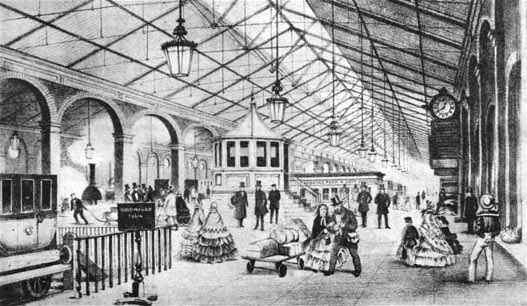
Fig 29. Chester station 1848
In order to force railways to carry poorer passengers and make rail travel available to all, the ‘Railway Regulation Act’ was passed in 1844. The act compelled the Railway Companies to operate at least one train a day over all of their lines at no more than 1d a mile. Railway travel thus became possible for the majority of Victoria’s subjects and was soon commemorated on thimbles. By 1845 the railways were carrying 30 million passengers a year and ten years later over a million passengers were being carried by rail. This age of tourism resulted in the development of popular resorts around the country with the parallel development of the souvenir industry. Thimbles made in both ceramic and precious metals were soon being made to satisfy the travellers need for simple souvenirs to take home or to friends.
The so-called ‘Train’ thimbles should possibly be called ‘Railway’ thimbles (2) because one such thimble came in a cardboard box with an engraving of the train on the lid which was inscribed ‘The Railway Thimble’. The thimbles are small in size, possibly for children, and are unmarked. They all have an early steam locomotive pulling a variety of coaches. The locomotives may be different and are difficult to identify.
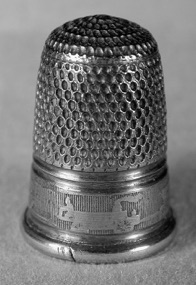
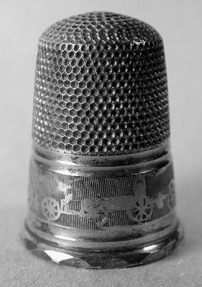
Fig 30
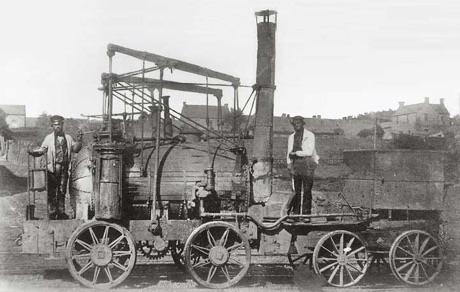
Fig 31
The left thimble (Fig 30) has a round turnover rim and depicts a locomotive which may be ‘Puffing Billy’ which was one of three similar engines built by Hedley, the resident engineer at Wylam Colliery, to replace the horses used as motive power on the tramway. ‘Puffing Billy’ remained in service until 1862. The driver sits at front and stoker at the back. The right thimble (Fig 30) has a turnover faceted rim and it possibly depicts another representation of ‘Puffing Billy’ (Fig 31).
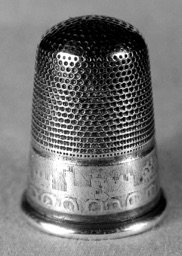
Fig 32
This thimble (Fig 32) has a round turnover rim and the locomotive appears to have a tender. The train seems to be travelling over a viaduct of some sort. It could be a representation of Robert Stephenson's locomotive, ‘Locomotion No 1’ (Fig 33).
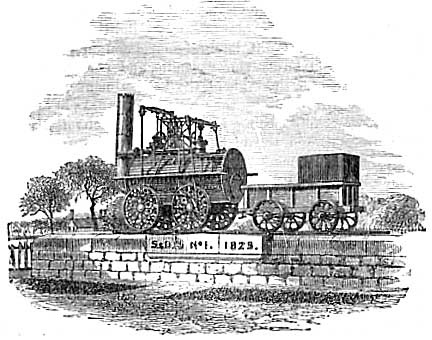
Fig 33
Boat
Canal boats and barges (Fig 34) were used extensively for moving heavy produce around the country on its highly developed canal system.
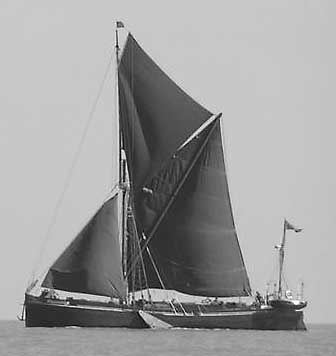
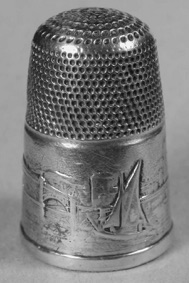
Fig 34 Fig 35
The thimble (Fig 35) depicts a Thames barge in front of an unknown Thames Bridge. There are no marks on the thimble, maker unknown.
Pleasure boats, steam paddle steamers and ferries carried Victorians on the rivers and estuaries to nearby pleasure sites.
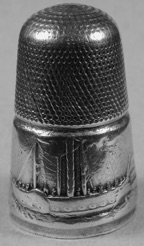
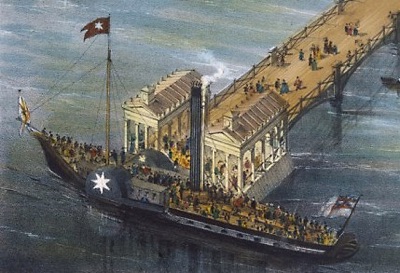
Fig 36 Fig 37
The thimble (Fig 36) shows an unknown Thames paddle steamer similar to the one shown docked at Gravesend (Fig 37), it has no markings and the maker is unknown §.
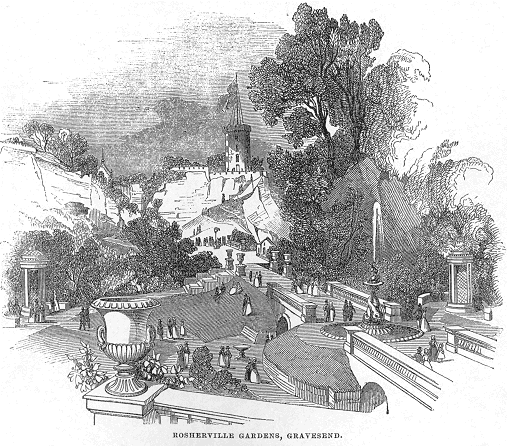
Fig 38
One of the destinations for these paddle steamers was Gravesend where the Rosherville Gardens (Fig 38) was one of the largest and most popular Victorian pleasure sites for Londoners. The gardens were built in a disused chalk pit which belonged to Jeremiah Rosher, after whom the gardens were named. A London businessman, George Jones, formed the ‘Kent Zoological and Botanical Gardens Co.’ who leased the chalk pit in 1837 and laid out the gardens. There was a terrace, a bear pit, an archery ground, a lake, a maze, flowerbeds, statues, a lookout tower and many winding paths.
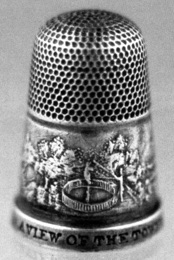
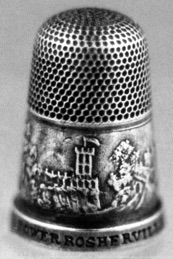
Fig 39
A silver souvenir thimble (Fig 39) depicts the lookout tower and bear pit and has ‘A view of the Tower Rosherville Gardens’ printed around its rim. Initially the gardens were intended to appeal to the wealthy with serious tastes, but sadly they never came in large enough numbers so that to save the gardens, the prices were lowered and less sophisticated entertainment was provided. From 1842, the Gardens became an enormous success and visitors flooded in.

Fig 40
One evening in September 1878, the paddle steamer ‘SS Princess Alice’ was returning from a day trip to the Rosherville Gardens when it was hit by a the coal boat ‘SS Bywell Castle’. The paddle steamer was hit amidships, broke in two, and within four minutes had sunk (Fig 40).
Approximately 700 passengers were aboard the ‘SS Princess Alice’ and between 69 and 170 were saved. Many people died because of the contaminated water which resulted from the direct discharge of raw sewage into the river at that time. This great loss of life heralded the decline of the Rosherville Gardens but it is possible that pleasure gardens would begin to go out of fashion also as soon as Londoners could afford train trips to seaside resorts.
Resorts
The London to Brighton railway line was very popular with Londoners and Brighton developed rapidly as a centre for tourism.
The Royal Pavilion, often called the Brighton Pavilion (Fig 41), was a former royal residence and was built in three stages. In the mid 1780s George, Prince of Wales (later King George IV), rented a small farmhouse overlooking the promenade in Brighton. In 1787 the architect, Henry Holland, was hired to enlarge the existing building, which became known as the Marine Pavilion.
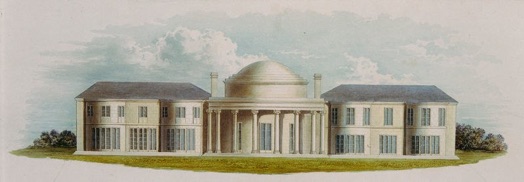
Fig 41. Marine Pavilion
George lavishly furnished and decorated the Pavilion in the Chinese style with Chinese export furniture and objects, and hand-painted Chinese wallpapers. In 1808 a new stable complex, built in an Indian style, was added and this had a lead and glass-domed roof and provided stabling for 62 horses.
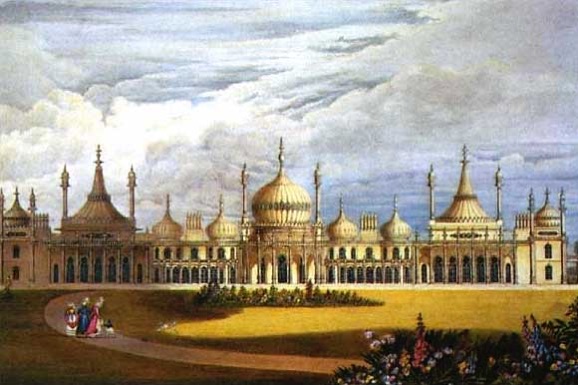
Fig 42. Brighton Pavilion 1826
Between 1815 and 1822, John Nash redesigned and greatly extended the Pavilion, and it is this Oriental looking building (Fig 42, 43) with its minarets, domes and pinnacles which can be seen today.
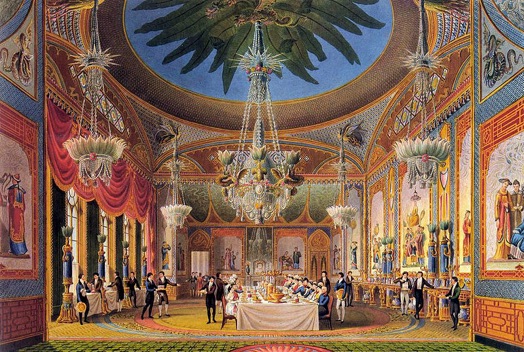
Fig 43. Nash designed Banqueting room
After the death of George IV in 1830, his successor King William IV stayed in the Pavilion on his frequent visits to Brighton but Queen Victoria disliked Brighton and its lack of privacy, especially when Brighton became more accessible to Londoners as a consequence of the railway.
Several silver souvenir thimbles were made depicting the Brighton Pavilion in the 1840s. The thimbles are usually unmarked and comprise a die stamped border and rim with a view of the pavilion, which is rolled into a cylinder and soldered to a dimpled, domed top. All of the early pictorial souvenir thimbles of the time were made in this way. A later Victorian thimble simply has ‘Brighton’ on the rim (Fig 44).
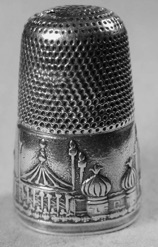

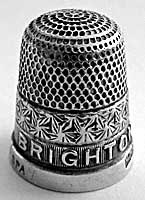
Fig 43 Fig 44
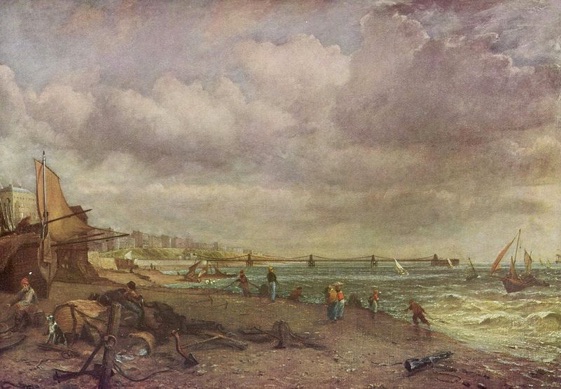
Fig 45
Victorians visiting Brighton would also have spent time on the ‘Chain Pier’ (Fig 45). The Royal Suspension Chain Pier was the first major pier built in Brighton. It was designed by Captain Samuel Brown and built, like a suspension bridge, in 1823. The chains were made of wrought iron and the suspensions were made of cast iron. The pier was primarily intended as a landing stage for packet boats to French ports, but there were also a small number of other attractions including a camera obscura. An esplanade with an entrance toll-booth controlled access to the pier. It became unsafe and was destroyed by a storm on 4 December 1896.
There are several unmarked silver souvenir thimbles of the Pier (Fig 46).
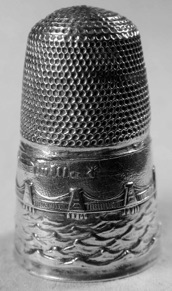
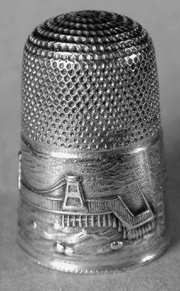
Fig 46
References
2. Aldridge E. Thoughts on Thimbles. Thimble Collectors International, 1983. pp. 49.
Holmes: ‘Commemorative Thimbles' pp. 173, 'Souvenir Thimbles' pp. 182.
§ Since writing this paper another paddle steamer thimble has been identified. The boat has two masts and a single funnel (cf. Fig 36) and is thought to represent the Royal Yacht ‘Victoria and Albert l’. The ‘Victoria and Albert l’ was laid down in 1842 and was designed by William Symonds. She carried two guns and was renamed ‘Osborne’ in 1855 when she was replaced by HMY Victoria and Albert ll.

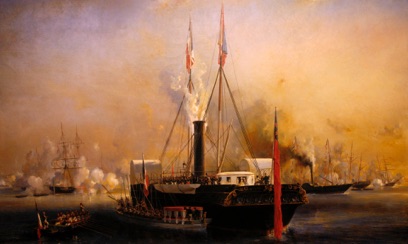
Researched and published in 2002/11
Copyright@2011. All Rights Reserved
Magdalena and William Isbister, Moosbach, Germany
Navigation
